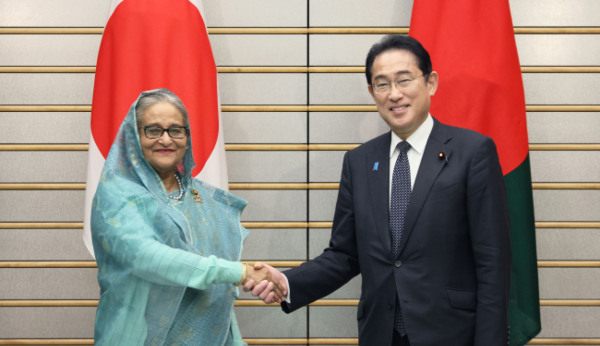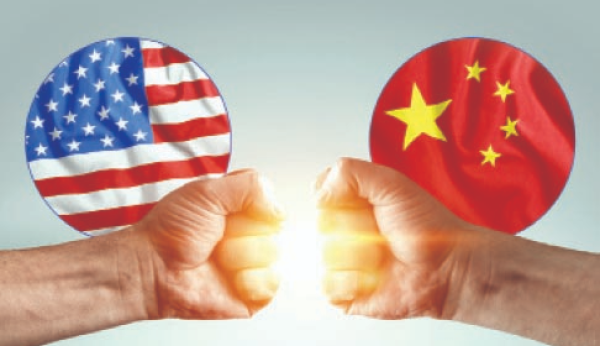New Equation of Japan-Bangladesh Bilateral Relations
New Equation of Japan-Bangladesh Bilateral Relations
New Equation of Japan-Bangladesh Bilateral Relations

The introduction to the Diplomatic Bluebook-2023 guidelines, which were released by the Japanese Ministry of Foreign Affairs in mid-April, was authored by Foreign Minister Hayashi Yoshimasa and began, “The world now stands at a turning point in history.” The prime minister of Bangladesh, Sheikh Hasina, will travel to the Indo-Pacific area from April 25 to May 9, according to sources at the Bangladesh Foreign Office. Visits are planned from Japan, the UK, and the UK. To demonstrate his impartial stance in the Indo-Pacific region, he issued the Indo-Pacific blueprint. How effective will this blueprint be in the near future in the global arena is a natural issue to ask. Or is it just short-term political expediency, or will it have long-term favorable and advantageous effects? Additionally, why is the tripartite tour’s hot topic in Japan? Is there a connection between the Diplomatic Bluebook and the Indo-Pacific Outline? Why is this trip crucial for raising foreign relations to their highest level in fifty years? Don’t you think it’s necessary to get the answers to all of these inquiries that come from deep within the mind?
From April 25 to April 28, Sheikh Hasina was in Japan to commemorate the 50th anniversary of Japan’s diplomatic ties with Bangladesh. In addition, the Foreign Office reported that during the Prime Minister’s visit, eight to ten memorandums of understanding and agreements are anticipated to be inked between the two sides. Additionally, it is reported that during this visit, Japanese Prime Minister Fumio Kishida will speak in-depth with Bangladeshi Prime Minister Sheikh Hasina about Japan’s plans to establish an economic hub in Bangladesh in order to access the markets of Northeast India, Nepal, and Bhutan. The historical bond between Bengalis and Japanese dates back many years. The Japanese parliament and intellectuals also extended a helping hand by raising enormous sums of money to aid Bangladesh’s freedom struggle, as was also known through the media that Japanese students saved their lunch money to help Bangladesh and stood by its side during the liberation war. The Japanese government invited Bangabandhu Sheikh Mujibur Rahman, who was the country’s prime minister at the time of independence, to visit Japan in 1973 as a mark of honor. Since Bangladesh’s independence, Japan has continuously provided assistance as an old friend.
In order to counter China’s expanding influence, observers claim that Japan is increasing its financial activities in South Asia as well as Southeast Asia. Tokyo, like Beijing, has contributed significantly to regional investment and development cooperation. Japan’s development assistance to Bangladesh is the most robust of all of them. Japan views Bangladesh as its main development partner, despite the fact that nations like Russia and China attempt to implement strategic geopolitical issues under the cover of development cooperation. In reality, it integrates the Pacific and Indian Ocean regions and significantly aids in the geopolitical environment’s economic growth. The Bay of Bengal, the largest bay in the world, is situated geographically in the northeast of the Indian Ocean. Bangladesh is situated in the north. Thus, there is a rising geostrategic demand for Japan.
The Economic Relations Department (ERD) estimates that Japan will provide Bangladesh $1,425 million in financial aid through 2019–20. More than 2.63 billion dollars have been pledged from the nation for the fiscal year 2020–21. During his visit to India last month, Japanese Prime Minister Fumio Kishida made an investment proposal with a focus on Bangladesh and India. A $127 million investment plan for Bangladesh is approved by Japan.
It is claimed that this visit is far more economic than merely political. Japan is making investments in southern Asia to counter China’s supremacy, which is referred to as “The Rising Power.” In this instance, if we look at the commercial history of Bangladesh-Japan investment, figures show that there has been $3 billion worth of trade between the two nations.
We send 1.2 billion US dollars to Japan, while we import 1.8 billion US dollars from Japan. In the 2017–2018 fiscal year, Bangladesh imported 1869.50 million US dollars while exporting 1131.90 million US dollars to Japan. In fiscal years 2018–2019 and 2019–2020, Japan exported items of USD 1365.74 million and USD 1200.78 million, respectively. Similarly to that, it brought in USD 1852.50 million in FY 2018-2019 and USD 1294.91 million in July through May of FY 2019-2020. It is important to know about Prime Minister-elect Shinzo Abe. Bangladesh Prime Minister Sheikh Hasina visited Japan in May 2014, and the late Shinzo Abe, then Prime Minister of Japan, visited Bangladesh in September of the same year. Bangladesh-Japan relations were able to reach a new height and dimension during his tenure as Prime Minister. Inspired by Japan’s cooperative behavior with Bangladesh at the time, Bangladesh overcame the excessive westward dependence of its diplomacy and, for the first time, began to prioritize eastward thinking. As a result, there is no denying that Shinzo Abe has played an indirect role in giving Bangladesh’s foreign policy a truly independent foundation.
It should be mentioned that Japan progressively became to be a significant donor nation to Bangladesh when the two countries established diplomatic ties following independence. Through various projects of socio-economic, technical, and cultural exchange, Japan started working on the reconstruction of war-torn Bangladesh during the post-independence era. Since 1950, Japan has helped Bangladesh develop economically and socially. A successful and reliable partnership between the two nations resulted in a result. Given that Japan is helping Bangladesh heavily to become a least developed country by 2026 and a developed country by 2041, Japan is one of Bangladesh’s largest development partners and a key source of aid. We are rebuilding our infrastructure and economy with the support in question.
The Diplomatic Bluebook 2023 has three significant new subjects. The post-Cold War era is finished, first of all. The most significant strategic threat to Japan is China, and the post-cold War era has come to an end. It is important to consider the southern nations seriously. The Bluebook for this year resolves Japan’s conundrum as well. That may be caught between Russia’s reliance on energy and the rise of South Asian confidence. Additionally, Japan will support multilateralism and “actively participate in a bridging role that bridges differences,” according to the new Blue Book. That demands a shift in perspective. The opposite is also true: one of Bangladesh’s four guiding principles is “friendship to all, malice towards none.” The refraining from using force in international relations, settling international disputes, and support for the tenets of UN law and charters have all been expressed, in addition to not meddling in the domestic affairs of other nations. It may be argued that both tend to prioritize national interests in order to promote their neutrality in international relations.
On February 10, 1972, Japan became the 28th nation to recognize Bangladesh as a state. Is there a gulf in the relations between these two nations if the history of relations between Bangladesh and Japan is brought forward? Keep in mind that every aspect of the bilateral relations between the two nations that occurred in the 51 years following 1971 is evaluated in total objectivity. Japan is unquestionably Bangladesh’s most strained ally, it may be argued. Palmerston, a previous prime minister of the United Kingdom, is quoted as saying, “We have no permanent friends and no permanent enemies. It is our responsibility to act as though our interests are fleeting. In modern international politics, this adage still holds true because: China is one of our economic partners in the third decade of the twenty-first century, despite its unsatisfactory situation in 1971. For Bangladesh’s strategic position in the Indo-Pacific region in the geopolitical equation, which can be understood by evaluating the Indo-Pacific outline, there is, however, no choice but to adopt a balanced position as a developing nation.
It is important to remember that commercial concerns currently govern every aspect of life. Economic politics increasingly dominate the world stage. To think of the 21st century without interests is simply absurd. Remember that the national interest necessitates the expansion of Dhaka’s diplomatic capital. Above all, the circular red sun that appears in both the flags of Bangladesh and Japan serves as a symbol of friendship and paints a clear picture of the two countries relations. The amicable diplomatic ties and mutually beneficial commercial ties between Bangladesh and Japan will be enhanced in the future, taking on new dimensions. Everyone’s hope and faith.
The author is a freelance writer & student
 Mohammad Maruf Mozumder
Mohammad Maruf Mozumder 










